
Chapter 5: Postsecondary Academic Program Choice and Workforce Outcomes
This study is part of a larger effort to understand the impact of postsecondary education on workforce participation and career success, R&P evaluated the importance of college major and short-term workforce outcomes. The University of Wyoming (UW) is the only public four-year degree granting institution in Wyoming. Along with seven community colleges, UW also receives financial aid through the Hathaway Scholarship Program (HSP). In order to effectively evaluate the success of the HSP, several broader research questions need to be addressed. In this article, R&P used the Classification of Instructional Programs (CIP) coding system along with data files provided by UW to evaluate workforce outcomes in Wyoming.
Literature Review
Harris (2015) examined the influences of certain life events (e.g., child birth and marriage) on young adults and their interaction with the economy. Harris found that 28.9% of females and 29.9% of males marry for the first time between the ages of 22 and 24. A similar pattern is also observed for births for this age group. The 22-24 age group is the age at which individuals graduate from four-year institutions and make important life choices, such as focusing on career or family. Further, R&P has conducted research regarding the instability of an individual’s employment (Glover, 2000; Glover, 2012; & Harris, 2015). Instability is the ratio of the number of times an individual changes employers at any given point compared to continuous employment across time. A higher ratio indicates higher employment instability. Results of these studies indicate that as people age, their instability index decreases, with large drops in the early- to mid-twenties.
Gender may play a significant role in choice of academic program. Due to social norms and expectations, the influences of family and friends, and potential workforce outcomes, males and females may enter college with specific views regarding academic programs. For example, Gayles and Ampaw (2014) found that females with high achievement in science and math courses in high school were more likely than males to complete a science- and/or math-related bachelor’s degree within six years.
Further, using data from the 1993 National Survey of College Graduates, Robst (2007) examined the mismatch between college major and accepted job positions. Similar to the results in this chapter, the author found that education, business management, and health professions were the most common majors among females, while engineering and business management were the highest for males. The amount of mismatch varied from 8% to 35% for females among these majors. For males, the mismatch was much smaller (11% to 14%). Females reported being mismatched mainly due to family-oriented restraints and working conditions, while males were mismatched for career-oriented reasons (e.g., promotional potential). These results indicate that workforce outcomes vary across gender and academic program choice and should be taken in account in evaluating the effectiveness of the HSP.
Methodology
CIP Codes
The Classification of Instructional Programs (CIP) code system is maintained by the National Center for Education Statistics (NCES) and is a system that categorizes two-, four-, and six-digit levels of instructional programs. For this article, R&P examined only the two-digit CIP families. For illustrative purposes, the CIP family of 45 (social sciences) includes academic programs such as anthropology, criminology, economics, and sociology. The CIP family of 13 (education) includes academic programs such as art teacher education, music, and educational psychology. A full listing of CIP codes can be found at http://nces.ed.gov/pubs2002/cip2000/.
Administrative Data
As previously stated, this article examines postsecondary and workforce outcomes in terms of age, gender, and academic program. R&P is able to accomplish this by linking administrative databases.
R&P collects and maintains quarterly wage record data through the Unemployment Insurance (UI) system from 1992 to present, which includes approximately 92% of Wyoming jobs. Also included in these data are wage records from 11 partner states (the states with which R&P has a data sharing agreement: Alaska, Colorado, Idaho, Montana, Nebraska, New Mexico, Ohio, Oklahoma, South Dakota, Texas, and Utah). For this research, these records were linked to UW graduate data for the academic years of 2006/07 to 2012/13 using masked identification numbers. These graduation data only include those who graduated with a bachelor’s degree during this period. The wages and employment for the quarter of graduation and the four subsequent quarters were included in the analysis. It should be noted that wages have been adjusted by the Consumer Price Index (CPI) to 2015 levels due to the variability of the years of graduation in the analysis.
Results
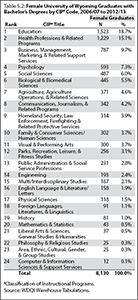
|
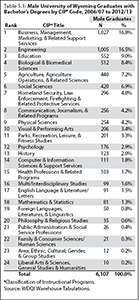
|
As shown in Table 5.1, the five most frequently occurring CIP programs among male UW graduates were business, management, marketing, & related support services; engineering; education; biological & biomedical sciences; and agriculture, agriculture operations, & related sciences. Business, management, marketing, & related support services and engineering accounted for 33.3% of all males who graduated from UW during this period.
Among female graduates, the five most frequently occurring CIP programs were: education; health professions & related programs; business, management, marketing, & related support services; psychology; and social sciences (see Table 5.2). Education and health professions & related programs made up 33.8% of all female UW graduates during this period. These results are similar to those of Robst (2007) and reflect the differences in academic programs in which males and females choose to enroll.
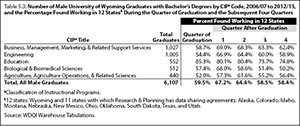
|
Tables 5.3 and 5.4 show the percentage of male and female graduates, respectively, from the five most frequently occurring CIP programs who were found working in Wyoming or a partner state during the quarter of graduation and the subsequent four quarters. As shown in Table 5.3, 85.3% of those who graduated with bachelor’s degrees in education were found working during the quarter of graduation, with a drop to 74.8% four quarters after graduation. Engineering, business, and biological sciences saw sharp increases in employment one quarter after the quarter of graduation, and biological sciences experienced the largest decrease over the four quarters. Just over half (50.2%) of those in the biological sciences were found working in Wyoming or a partner state four quarters after graduation.
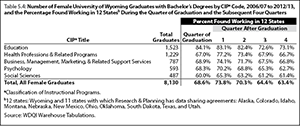
|
Female graduates showed similar trends across time regardless of academic program (see Table 5.4). As with males, the largest percentage of females who were found working in Wyoming or a partner state during the four quarters after graduation were those with a bachelor’s degree in education. Both males and females from this CIP showed substantial declines in employment in the third quarter after graduation. This result may indicate that teachers and other educational staff enter educational employment and find the job does not fulfill their career goals and move elsewhere.

|
Table 5.5 shows the average quarterly wage for males from the five most frequently occurring CIP programs who were found working in Wyoming or a partner state. Males who graduated in engineering saw the largest increase in quarterly wages the first quarter after graduation (an increase of $4,385). Biological sciences experienced the smallest increase (an increase of $1,573) and experienced little fluctuation in subsequent quarters.
Table 5.6 shows average quarterly wages for females from the five most frequently occurring CIP programs who were found working in Wyoming or a partner state. Health professions had the highest quarterly wages for each quarter examined. These individuals were likely nursing students who entered the health care field, such as in hospitals and outpatient clinics. R&P currently has access to health care licensing board files, which could be used in future research to examine the educational and career paths of nurses throughout the state.
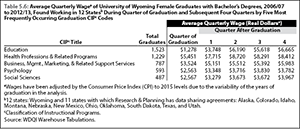
|
Females who graduated with bachelor’s degrees in education saw a sharp increase in wages over the first two quarters after graduation, which may be an indication of these graduates entering the market and taking high paying teaching positions. For a more complete analysis of Wyoming’s educational labor market, please see http://doe.state.wy.us/LMI/education_costs/2013/monitoring_2013.pdf.
This chapter examined the variable of academic program choice and labor market outcomes. Several limitations should be noted. First, R&P did not examine individuals who earned graduate degrees (e.g., master, Ph.D., or professional) within the state. As mentioned earlier, age is a factor in terms of wages, and these individuals should be examined as a separate group. At the time of publication, R&P had wage record information through first quarter 2015. This limited the ability to track individuals in more recent years. Due to the low count of graduates with certain CIP codes, this chapter examined graduates at the two-digit CIP code only. Future research should explore more detailed academic programs where possible (e.g., education and health professions).
References
Gayles, J.G., & Ampaw, F. (2014). The impact of college experiences on degree completion in STEM fields at four-year institutions: Does gender matter? Journal of Higher Education, 85, 439-468.
Glover, T. (2000). The instability index as a measure of labor market activity. Wyoming Labor Force Trends, 37(3). Retrieved April 20, 2016, from http://doe.state.wy.us/LMI/0300/a3.htm
Glover, T. (2012). A decade later: Tracking Wyoming’s youth into the labor force. Retrieved April 20, 2016, from http://doe.state.wy.us/LMI/w_r_research/a_decade_later.pdf
Harris, P. (2015, May). Youth transitions: Life events and labor market behavior. Wyoming Labor Force Trends, 52(5). Retrieved April 20, 2016, from http://doe.state.wy.us/LMI/trends/0515/a1.htm
Robst, J. (2007). Education, college major, and job match: Gender differences in reasons for mismatch. Education Economics, 15, 159-175.